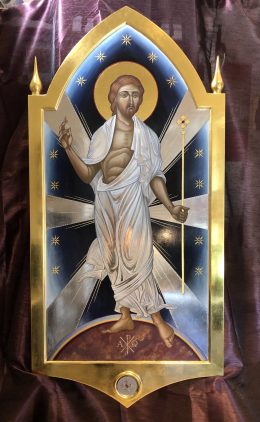Christi Lux Mundi – A new sanctuary icon for All Hallows Church, Gospel Oak, London

In the beginning The idea for a sanctuary icon was first mooted in late January 2020, from the outset, Fr David Houlding envisaged that it should be an image “which speaks of the glory of God” and that it would convey “the glory coming from the Sanctuary in a way that would permeate the whole building…”
Certain icon commissions (in my 37 years’ professional experience) sometimes take on a mission of their own and evolve incrementally to become something which can not only function on several different levels simultaneously – but also allows for new interpretations of an ancient tradition. This is only possible when the iconographer is fortunate enough to be trusted with a free hand in terms of the design, given the means to use the very best materials, and most importantly, given the time and support to bring it all together – all of which were given to me by Fr David.
The initial brief with its need to connect the image to the sacramental action of the altar was quite enough of a challenge. A site visit reassured me that Fr David’s vision would be best realised through the iconography of the Resurrected Christ. Little did we realise how appropriate this theme would become. Within a few months, it was tragically all too clear the icon would need to commemorate the lives of those loved ones who had been taken from the All Hallows parish family during the Covid-19 pandemic. In addition, the icon also stands in recognition of the selfless work and sacrifice of all those frontline individuals who helped us through those two years, particularly those working in the NHS.
Design matters This work was never intended to be a ‘holy icon’ in the tradition of the Eastern Orthodox church, it is a contemporary western icon made for an Anglican church. This image was composed to hybridise Latin iconography of the Risen Christ with certain Byzantine elements and motifs (e.g., The Transfiguration).
The figure stands in a classical, contrapposto pose, robed but not fully covered to reveal the side-wound. The robes ‘flutter’ either side of the figure – a Byzantine formula adopted in the medieval west and only used for images of the Resurrected Christ. The figure stands within a mandorla, an almond-shaped, sacred zone of heavenly blues graduating into the blue-black of Uncreated Light and punctuated with six broad rays of light and Byzantine eight-pointed stars.
Lux Mundi In order to fulfil the brief of ‘glory’ radiating from the sanctuary, I needed to use materials and techniques that would reflect light and create this phenomenological effect. Inspired by the Greek concept of poikilia (simplified here to imply the affective, sensory experience of encountering a variety of fabulous things) and the 12th century technique of translucidia, a process of painting on precious metal, described in Theophilus’ De diversis artibus, I was able to devise a methodology for the making the icon to be as radiant, bright and light-reflective as possible. It was at this stage, I decided on the title Christi Lux Mundi. The imperial purple coloured, lower hemispherical section however, uses a marbling technique with gold dust which is entirely my own method, devised for this commission. The Chi Rho is in platinum.
The panel itself was a bespoke order from a maker in the Veneto region of Italy, it is made of linden wood with the traditional gesso ground. The shape itself echoes the arches of the nave and windows of All Hallows. The painted parts of the figure were executed in egg tempera, using another method from Theophilus. The robes however, were executed in casein and oil glazes, using the translucidia technique over genuine palladium.
Seeing eternity The six rays are literally cosmic. They are ‘gilded’ in genuine platinum leaf, one of the most precious metals found on our planet. However, both platinum and palladium (the metal used for the robes) are now believed by some scientists to have originated extra-terrestrially in the cosmos, formed (according to one source) aeons ago from minerals metamorphosed by the intense pressure of an imploding/exploding star and brought to our planet by meteorites… (The analogy of something precious and strong resulting from destruction seems a very appropriate message for this icon to convey). Platinum and palladium are both extremely hard, tough metals and difficult to work with (compared to the soft malleable gold leaf used for the halo and borders).
War & Peace. Coincidentally, both of these ‘white’ precious metals are found in deposits in the Eastern Ukraine and are one of the resources currently being fought over. This icon, planned before the war – but completed during the first few months of this shameful Russian atrocity, thus becomes an image which calls for peace.
The Platinum Jubilee One other, very different and happy event closer to home is also referenced in the use of platinum in this icon – symbolising the 70 years of service our Queen Elizabeth has given. The history of our times is therefore fully present in this icon.
The Prayer Point Further enrichment is found in the two amethysts present on the icon; one amethyst embellishes the Crozier of Victory – and the other sits at the centre of the ‘prayer point’, with its corresponding cross in the roundel, on the lowest part of the panel. This prayer point is designed to be touched; it is the place where prayers are made – and which are then acknowledged in the cross held triumphantly by the Christ who is the Light of the World.
The icon was blessed and installed on 5th June, 2022, during a Solemn Mass of Pentecost by the Bishop of Fulham, the Rt Reverend Dr Jonathan Baker